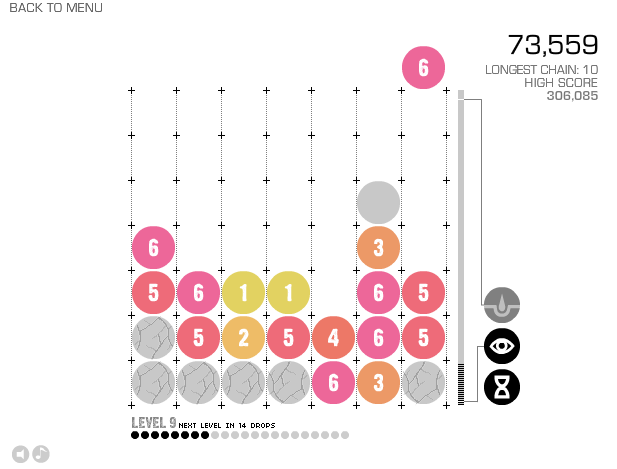36th game played so far
 Genre: Puzzle
Genre: Puzzle
Platform: PC/iPhone
Year of Release: 2008
Developer: Area/Code
Sometimes all you need is a decent puzzle game. Today’s blog post, Drop7, is our first puzzle game in a while. It also helps that since Final Fantasy VIII took us an age that we could spend an afternoon on this to try to make up some of the time lost.
For the sake of ease we have delved into Drop7’s original internet incarnation Chain Factor which by all accounts (of what we read both in print and online) is the same game. This is available for free here and we would love your opinions on this game as well.
Our Thoughts
Here’s a nice, short game to discuss. We really did need a game that could be covered in as short a time as possible to make up for the time taken for this blog’s previous offering. And this was a good one we came across as I was researching some games to discuss. Found it online, clicked it and I very much enjoyed it from the start. It’s a game I remember from university… a real little time eater this one. I hadn’t heard of it before, but seemed to get it quite easily. The coveted goal of all simple online puzzles really. The combination of a premise anyone can understand that is also addictive in nature. (And get better than his partner at within a few minutes) (Makes sense that I excel better at games involving quick decisions whilst you flourish with those of a more cerebral nature)
What makes this game all the more extraordinary is that it was really made as a marketing ploy for the American procedural drama Numb3rs. Basically, doing well at this game was one of the ways of moving a metaplot along that preceded the release of the series, one that involved public billboards, secret websites and more of such things for those people who got more involved with that side of things. Dropping numbers was just as useful. Nice to think that my taking time out of my degree helped the advancement of the metaplot of a TV show that I had never heard of. I’m sure you must’ve felt so proud. Not even out of university and already a slave to media.
Now, for the game itself, it’s worth mentioning that this was released as ‘Drop7‘ for the iPhone, and that’s the title it is listed as in the book. As we don’t have an iPhone to play it on, and the book includes the original, we’ve played the online version at http://chainfactor.com/ instead. In gameplay, they’re very similar, the main differences are in look and in a game mode or two that were slightly modified. The gameplay stays the same. I guess that the only way that the games would possibly differ is the implementation of the iPhone’s touch screen. This would make the game somewhat feel more intuitive since you are able to have a greater degree of control over which column… but then there is the constant threat of a finger slip leading to a game over. Which means it basically ends up working similar to the mouse controls of the Flash version. Also, I think that the graphics also remain on a similar enough levels between the two ports. Yeah, they seem to be.
Now, the game itself. It’s quite simple: You get these numbers on discs and drop them in columns. The numbered discs disappear when they’re in a horizontal or vertical group of their number’s length – so a ‘3’ disc disappears if there are three discs horizontally or vertically, with gaps next to them. There are grey discs, that need to be cleared in two goes by having a block disappear next to them, that become numbered discs afterwards. You can, in some game modes, enable further powers, but that’s it. The challenge is to combine them for as many points as possible without having the blocks in a column reach the top, not helped by the row of blocks being shoved in at the upper side before. One thing that is very important about this game is that you get just as far through sheer strategy as you can through dumb luck. There is something rather satisfying about watching the blocks fall and explode in the midst of a chain reaction. Something that lies at the heart of every good puzzle game is it’s ability to let you sit back and revel in your triumphs. Yes, we know how stupid but it’s a fundamental truth about the life of a gamer. How else would you explain the popularity of Minecraft? Not a game we’ve gotten into.
And that’s one thing the game does. It’s addictive and makes time pass faster than you think. What more could you want there? How about for every chain reaction it sent me an Amazon gift card? I do long for a Playstation 3. Patience, love, patience…
Final Thoughts
Who says that you need a budget of millions and a staff of hundreds to turn out a work of addictive genius. We will be covering other games which, like both this and Audiosurf, were produced far more frugally. Proof, if it were needed, that a simple well executed idea can outshine a glossy convoluted mess.
[…] after finishing our write-up, we will be targeting more obscure games (granted Quadradius and Drop7 are fairly unknown but that’s by the by) as well as some interesting looking arcade games […]
[…] other games have inspired further delving on my own steam. The games Drop 7, Bayonetta, Quadradius and Second Sight have all been played after we finished writing their […]
[…] since we played Drop 7 we of Pong and Beyond have been attempting to limit the number of puzzle games we cover since we […]